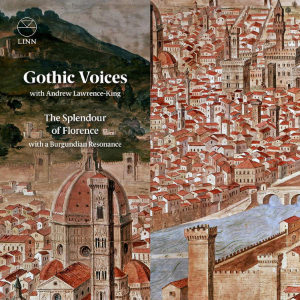
The Splendour of Florence with a Burgundian Resonance
Gothic Voices
Andrew Lawrence-King (harp)
rec. 2022, Boxgrove Priory, Sussex, UK
LINN CD700 [75]
The famous fifteenth-century bird’s eye view of Florence by Francesco Rosselli (c.1500) appears on many a cover for a book or record. Julian Podger in his booklet essay tries to make a case for the rather disparate but very fine works. Each of them is connected to the great city, undoubtedly the hub of artistic creativity at the start of the period we now call the Renaissance, when the emphasis came to be the development of the individual and a revival of interest in the antiquity.
One of the leading composers of the period, Guillaume Dufay, certainly can be associated with the rise of the city and with the eventual consecration of Brunelleschi’s Duomo in 1436. For that occasion, he composed the remarkable isorhythmic motet Nuper rosarum flores which concludes the programme. Its tenor part – on the opening track here – is the plainchant Terribilis est locus iste (Awesome is this place) which no doubt applies to the somewhat austere cathedral.
But how about the remaining music? The subtitle ‘with a Burgundian Resonance’ suggests that Gothic Voices include the composers of the Franco-Flemish school with Florentine sensibilities, many of whom would have visited the city. Podger tells us how the programme has come about. First, to praise Florence for the beauty of its women, then to move to “enamoured devotion and chivalry and grief and loss in the chansons and the equivalent sacred devotional themes”. We also have devotion to faith, loss and uncertainty, including war and fear. There are, then, a number of roads into the background of this collection of works, which almost appear to be too diverse.
When Christopher Page presided over Gothic Voices, there was almost no mixing of voices and instruments. In the past few years, they have included a limited instrumental colour, as here with Andrew Lawrence-King on several types of harp. On the whole, it works well and I like it, but not always. Take Dufay’s De ma haulte et bonne aventure. I much prefer the version by John Elwes accompanied by the clear flexibility of two fiddles directed by Peter and Timothy Davies (five CDs of Dufay’s complete secular music on L’Oiseau Lyre 452 557-2). But songs played just on the harp work well, for example Dufay’s beguiling De tout m’estoie abandonnie.
Another interesting comparison might be the Orlando Consort’s recent recording The Florentine Renaissance (review), which includes Nuper rosarum and Mirandas parit haec irbs. If you can forgive the vibrato in some of their voices, these a capella performances have clarity and lucidity. Gothic Voices are equally thoughtful and meticulous in their rendition of these complex works, but the presence of the harp makes the motet more like a chanson. (I do not think for one minute, however, that either represents the way the pieces were first heard.) There is a particularly impressive recording of this motet by the Huelgas Ensemble, on Harmonia Mundi 901700; sackbuts proudly sound out the Terribilis plainchant.
The booklet has the essay, photograps and all of the texts. Some texts have been anonymously and oddly translated, so we get curious inverted syntax, especially in Mon seul et cele souvenir.
The more I got into this disc, the more I enjoyed it, both the choice of repertoire and the performances. There is no doubt that anyone with an interest in the music of the period should snap this disc up a.s.a.p.
Gary Higginson
Help us financially by purchasing from



Contents
ANON
Terribilis est locus iste (plainchant)
Guillaume DUFAY (c.1397-1474)
Mirandas parit haec urbs
Firminus CARON (fl.c1460-1475)
Rose playsante odorant
Johannes OCKEGHEM (c.1410-1497)
D’ung aultre amer
OCKEGHEM
Alma redemptoris mater
Loyset COMPÈRE (c.1445-1518)
Dictes moy toutes penses
Antoine BUSNOIS (c.1430-1492)
Mon seul et cele souvenir
OCKEGHEM
Aultre Venus estessans faille
DUFAY
Lamentatio sanctas matris ecclesias Constantinopolitanae
ANON
Concupivit rex (plainchant)
DUFAY
Du tout m’estoie abandonne (solo harp)
Hayne van GHIZEGHEM (c.1445-1497)
De tous biens plaine
DUFAY
De ma haulte et bonne aventure
Alexander AGRICOLA (c.1445-1506)
J’ars de desir
ANON
Terribilis est locus iste (plainchant respond and verse)
Johannes TINCTORIS (c.1435-1511)
Virgo Dei throno digna
BUSNOIS
Terribile fortuna (solo harp)
ANON
Gloria patri (Terribilis est, doxology and respond)
DUFAY
Nuper rosarum flores


















